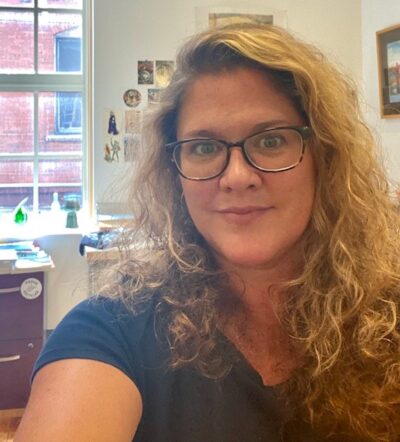Biography
Heather Stark is an Associate Professor of Art History in the School of Art and Design. With undergraduate and master’s degrees in art history and painting, she received her Ph.D. in Interdisciplinary Arts from Ohio University. She teaches the history of nineteenth and twentieth century art and design, art and architecture of the Renaissance, and introductory and survey art history courses. She is an advocate for undergraduate study abroad, and led her college’s annual trip to Florence, Italy four consecutive years, offering courses in both studio and art history. Her research is focused on the intersection of visual art, literature, and aesthetic theory during the interwar period in America, specifically through the painting and experimental filmmaking of Charles Sheeler. More recently she has begun a study which seeks to contextualize Appalachia within the history of modern and contemporary earthworks, looking closely at the work of Maya Lin. She has presented this research at several conferences, including SECAC, the Appalachian Studies Association, the Society for Educating Women, and the Society for Paragone Studies. She is currently the SECAC Mentoring Program Coordinator and has served on the Board of Directors since 2014. Dr. Stark was a 2020 recipient of the SECAC Excellence in Teaching award.
Statement of Teaching Philosophy
One of the most challenging and important responsibilities of an art history educator is to create an environment that fosters a balance of active engagement and discussion with open dialogue and exchange. When a student can begin to concisely expound upon form, materials, content, and context in the art history classroom, this space can become a forum for creative and conceptual thought. Whenever it is possible to provide hands-on experiences within a particular field of study, the knowledge gained through this contact will greatly enhance retention. Whether in the art history classroom, the studio, or abroad, I am intent upon providing students the opportunity to interpret, analyze, and articulate the views they have formed through experience and reflection. The latter of these is two-fold, encompassing both course material and self-reflection. The classroom must be a space that both inherently welcomes and supports students of diverse personal and geographical backgrounds, and also strives to incorporate works reflective of these differences, while conveying an understanding of chronology and those voices removed from the canon.
Whether inside or outside of the classroom, a student’s ability and comfort toward approaching their instructor is of utmost importance. Approachability comes through the awareness that as educators we are continually learning from our students. Approachability opens lines of communication within the classroom, inspiring creative and collaborative discussion. Without a basic attempt to understand the student’s point of view teaching can become an exercise in futility. This understanding may come through experimentation within methodology and evaluation. My interdisciplinary background has been integral to this realization. In the same realm as accessibility, flexibility can make or break a classroom experience. Flexibility is essential to the creation of an experience that aims to readily adapt to student ideas and input. Through the cultivation of their opinions and ideas, students may begin to see beyond the “black and white” of true and false. The acceptance of this “gray” area can only work to expand creative potential and critical thinking. This expansion can lead a student toward the important process of questioning perceived beliefs.
Establishing relationships between artworks discussed in class and in the field and elements of our everyday experience will foster comprehension of the prominent role visual art holds in our lives. I strive to help students realize their own motivations and ability to experiment and problem solve. By providing students with an open but consistent classroom structure, I allow them to drive their own growth through self-directed research. My background as both a painter and an art historian has enhanced my ability to guide students through layered and varied points of view encompassed by both scholars and practicing artists. As an educator, I strive to provide students with a context through which to view a diverse array of art and artists, while remaining cognizant of our twenty-first century perspective.
